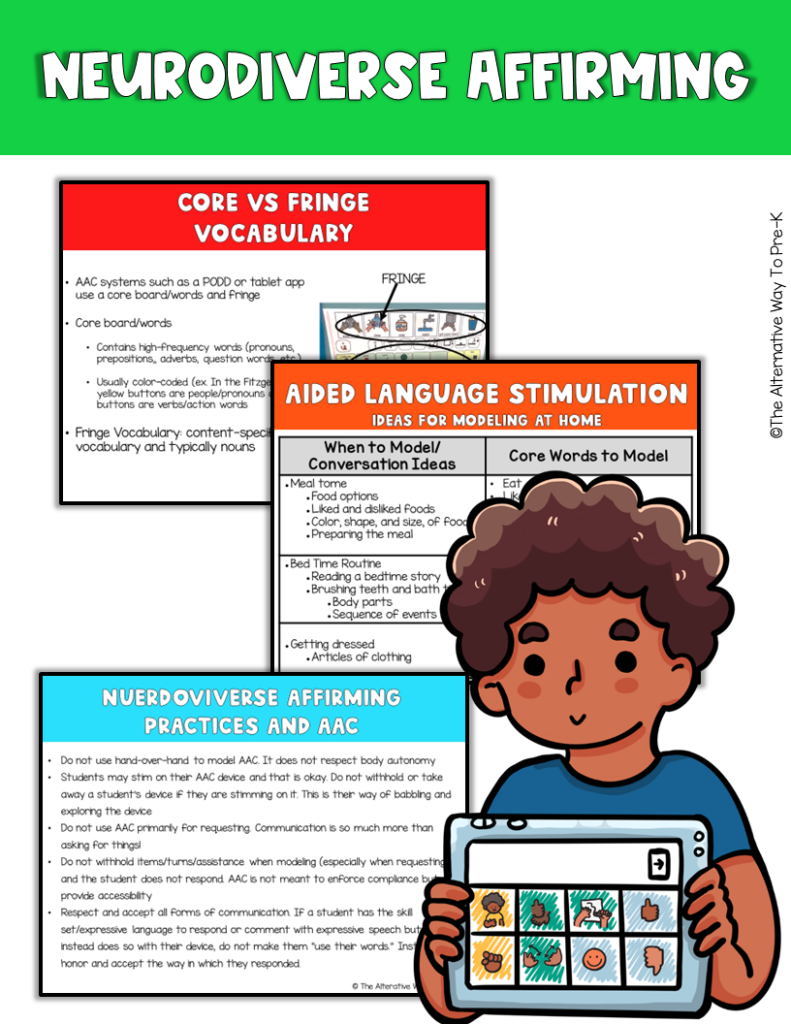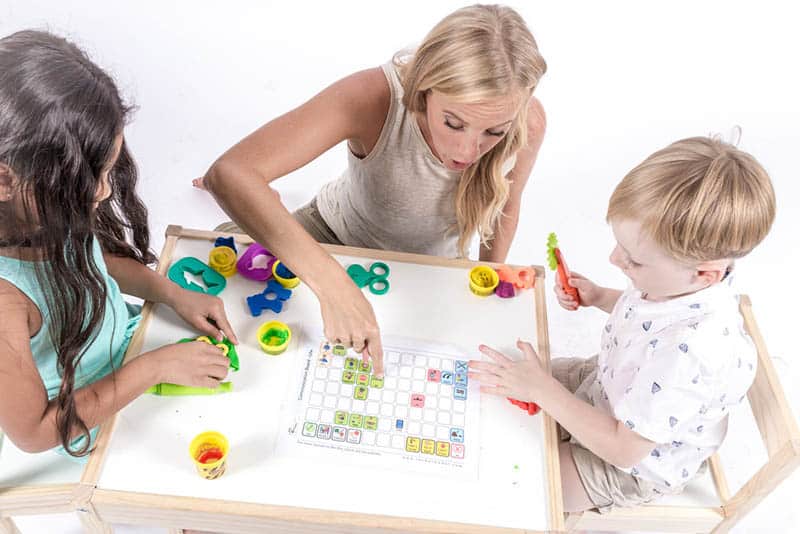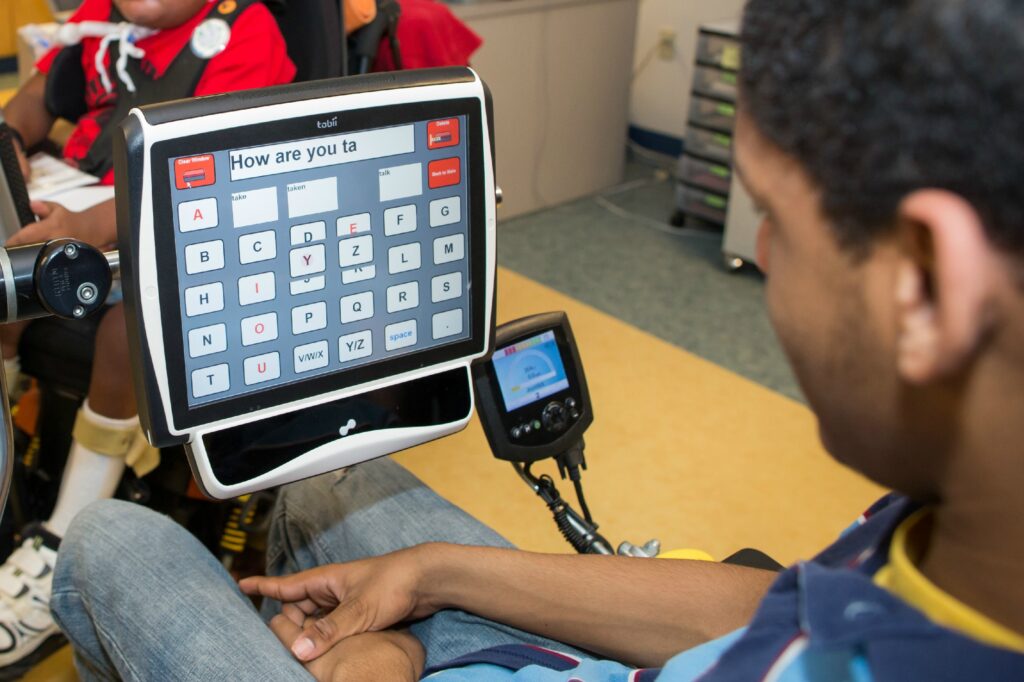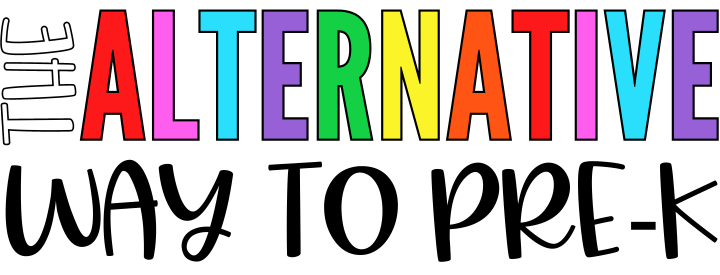One of my most asked questions from teachers and SLPs is how to create AAC buy-in. This can be from parents/guardians, related service providers, general education teachers, special education teachers, paraprofessionals, or anyone who works with an AAC user.
Having all team members understand the importance and correct way to implement AAC is HUGE for students’ success with it. Creating AAC buy-in is hard. There is no one clear-cut answer, BUT I have some tips I have used over the years to get those stubborn communication partners to model and implement AAC.
1)Education
First and foremost, ALL team members need to be coached on what AAC is, why we use it, and how we use it. And when I say all, I mean ALL.
This means every adult will be interacting with that student: cafeteria workers, art teachers, from the office, staff, siblings, EVERYONE! You can do this either one-on-one or in a small group.
Now, this may just be the special education teacher in me, who differentiates for all learners, but I like to use different mediums to do this. Typically, I will create a slideshow with the basics. Within that slideshow, I have lots of graphics, visuals, and videos. I will even do a simulation of a conversation with whomever my audience is so they get that hands-on experience.
From my experience, the simulation and videos are the most effective. It puts into perspective how easy it is. People tend to overthink AAC and modeling when in reality it is super simple. If you are looking to save some time, I have already made an AAC Training Guide for you. You can find it HERE!



Keynote: Within this coaching session I always make sure to emphasize these five things 1) model without expectation 2) do not withhold or take away a student’s device 3) AAC is not just for choice making 4) presume competence 4) accept all forms of communication
2)Environment

The environment is a huge component when it comes to AAC buy-in. This goes for in school and at home. When you have an AAC-rich environment it makes all users and communication partners more inclined to use it because accessibility is increased.
So, what does an AAC-rich environment mean? Well, for starters, let’s have all the AAC devices near our students at all times, and if they are high-tech, make sure they are charged. On top of that, we want to incorporate the student’s access mode in all areas of the classroom just in case their device happens to get thrown on the other side of the room or snatched up by another student.
For example, a printed-out version of the high-tech device core board, a low-tech core board with related fringe, an object symbol, or a pre-programmed switch in each specific area.
Yes, that is a lot, I know. However, the adults you are trying to create buy-in with and the AAC user themselves now have increased accessibility. This also gives the adults involved no excuse not to use it.
Another part of an AAC rich in the environment is you! If you’re a teacher, OT, PT, or whoever you are, lead by example. Make sure you are modeling without expectation with all students. If they do not see you using it, then why would they do it? Guide through your actions and not your words
3)Creating “Aha Moments”
Humans, by nature, want instant gratification. We want to see things work NOW! AAC is a journey. Depending on the user, it can be anywhere from weeks to months for us to see progress.
The communication partners that do not see a student instantly using their AAC are the tough ones to crack. These people usually are the ones to say, “Oh, he just plays with it,” or “She doesn’t even use it.” I always like to respond with “doesn’t use it YET.” For individuals with this mindset, we must create an “aha moment.” What does this mean? We need to create an opportunity for them to see AAC working.

I always start with a snack or meal time. Why? It is routine, it’s highly preferred for students, and it opens the door for tons of different conversations. Now let me preface that AAC is NOT just for choice making, nor is using food as a reinforcement neurodiverse affirming.
However, for the purpose of creating buy-in for those doubting communication partners, start there. This is typically one of the first areas where we start to see students use AAC successfully.
For example, if you offer the choice of cookies or crackers, and the AAC user chooses one using AAC, and the doubting communication partner sees that you have just created an “aha moment.” We want to use that as a moment and then generalize it to another area.
Coach the individual to model making another choice in a different area, such as center time. Then, build on that. Coach them to model a two-word utterance with the center, such as “See car.” Just like our students learning AAC, adults need to learn and generalize it, too. It’s progress over perfection.
4)Follow Up
Just like when we are teaching, we have to check for understanding. Make sure you follow up with those you have coached. Check and see if they need a refresher or are still confused. Invite them to watch you in action. Provide them with additional resources or even accounts to follow.
These are two of my favorite resources
Getting Started with AAC and Busting AAC Myths
Some of my favorite AAC accounts to follow on Instagram are
@aacforall @the.aac.coach @chickadee.aac @tobii_dynavox @bohoospeechie @beautifulspeechielife @emilydiazslp
5)Have a tough conversation

Okay, so you did the coaching, the AAC-rich environment, and everything else, but that one person is still dragging their feet. This is when you may need to have tough conversations. If it is a school employee, emphasize that AAC is on their IEP and we are legally obligated to implement it. Stress that it allows the student to access all aspects of their day: academic, social, daily living, and EVERYTHING.
When it comes to parent/guardian buy-in, it’s a little trickier. We are not in the student’s home. We can only control our immediate environment at school. This one may seem like you’re beating a dead horse, but you just have to keep highlighting how important AAC is for their child both in and out of school.

